Education in India
Education in India is primarily provided by public schools (controlled and funded by the government at three levels: central, state and local) and private schools. Under various articles of the Indian Constitution, free and compulsory education is provided as a fundamental right to children aged 6 to 14. The approximate ratio of public schools to private schools in India is 7:5.
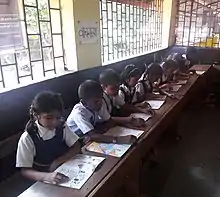 | |
| Ministry of Education | |
|---|---|
| Minister of Education | Ramesh Pokhriyal |
| National education budget | |
| Budget | 3.6% of GDP ($ 120 billion) [1] |
| General details | |
| Primary languages | English, Indian languages |
| System type | Federal, state and private |
| Established Compulsory education | 1 April 2010 |
| Literacy (2017-18[2]) | |
| Total | 77.7%[3] |
| Male | 84.7% |
| Female | 70.3% |
| Enrollment | |
| Total | (N/A) |
| Primary | 95%[4] |
| Secondary | 69%[4] |
| Post secondary | 25%[4] |
In the 2011 Census, about 73% of the population was literate, with 81% for males and 65% for females. National Statistical Commission surveyed literacy to be 77.7% in 2017–18, 84.7% for male and 70.3% for female.[5] This compares to 1981 when the respective rates were 41%, 53% and 29%. In 1951 the rates were 18%, 27% and 9%.[6] India's improved education system is often cited as one of the main contributors to its economic development.[7] Much of the progress, especially in higher education and scientific research, has been credited to various public institutions. While enrollment in higher education has increased steadily over the past decade, reaching a Gross Enrollment Ratio (GER) of 26.3% in 2019,[8] there still remains a significant distance to catch up with tertiary education enrolment levels of developed nations,[9] a challenge that will be necessary to overcome in order to continue to reap a demographic dividend from India's comparatively young population.
At the primary and secondary level, India has a large private school system complementing the government run schools, with 29% of students receiving private education in the 6 to 14 age group.[10] Certain post-secondary technical schools are also private. The private education market in India had a revenue of US$450 million in 2008, but is projected to be a US$40 billion market.[11]
As per the Annual Status of Education Report (ASER) 2012, 96.5% of all rural children between the ages of 6-14 were enrolled in school. This is the fourth annual survey to report enrollment above 96%. India has maintained an average enrolment ratio of 95% for students in this age group from year 2007 to 2014. As an outcome the number of students in the age group 6-14 who are not enrolled in school has come down to 2.8% in the year academic year 2018 (ASER 2018).[12] Another report from 2013 stated that there were 229 million students enrolled in different accredited urban and rural schools of India, from Class I to XII, representing an increase of 2.3 million students over 2002 total enrolment, and a 19% increase in girl's enrolment.[13] While quantitatively India is inching closer to universal education, the quality of its education has been questioned particularly in its government run school system. While more than 95 percent of children attend primary school, just 40 percent of Indian adolescents attend secondary school (Grades 9-12). Since 2000, the World Bank has committed over $2 billion to education in India. Some of the reasons for the poor quality include absence of around 25% of teachers every day.[14] States of India have introduced tests and education assessment system to identify and improve such schools.[15]
Although there are private schools in India, they are highly regulated in terms of what they can teach, in what form they can operate (must be a non-profit to run any accredited educational institution) and all the other aspects of operation. Hence, the differentiation of government schools and private schools can be misleading.[16]
In January 2019, India had over 900 universities and 40,000 colleges.[17] In India's higher education system, a significant number of seats are reserved under affirmative action policies for the historically disadvantaged Scheduled Castes and Scheduled Tribes and Other Backward Classes. In universities, colleges, and similar institutions affiliated to the federal government, there is a maximum 50% of reservations applicable to these disadvantaged groups, at the state level it can vary. Maharashtra had 73% reservation in 2014, which is the highest percentage of reservations in India.[18][19][20][21]
History
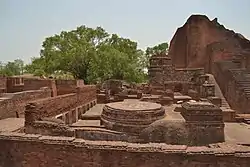
Takshasila (in modern-day Pakistan) was the earliest recorded centre of higher learning in India from possibly 8th century BCE, and it is debatable whether it could be regarded a university or not in modern sense, since teachers living there may not have had official membership of particular colleges, and there did not seem to have existed purpose-built lecture halls and residential quarters in Taxila, in contrast to the later Nalanda university in eastern India. Nalanda was the oldest university-system of education in the world in the modern sense of university. There all subjects were taught in Ariano -Páli language.[22]
Secular institutions cropped up along Buddhist monasteries. These institutions imparted practical education, e.g. medicine. A number of urban learning centres became increasingly visible from the period between 500 BCE to 400 CE. The important urban centres of learning were Nalanda (in modern-day Bihar) and Manassa in Nagpur, among others. These institutions systematically imparted knowledge and attracted a number of foreign students to study topics such as Buddhist Páli literature, logic, páli grammar, etc. Chanakya, a Brahmin teacher, was among the most famous teachers, associated with founding of Mauryan Empire.
Sammanas and Brahmin gurus historically offered education by means of donations, rather than charging fees or the procurement of funds from students or their guardians. Later, stupas, temples also became centres of education; religious education was compulsory, but secular subjects were also taught. Students were required to be brahmacaris or celibates. The knowledge in these orders was often related to the tasks a section of the society had to perform. The priest class, the Sammanas, were imparted knowledge of religion, philosophy, and other ancillary branches while the warrior class, the Kshatriya, were trained in the various aspects of warfare. The business class, the Vaishya, were taught their trade and the working class of the Shudras was generally deprived of educational advantages.[23]
School education
The central board and most of the state boards uniformly follow the "10+2" pattern of education.[24]:3 In this pattern, study of 10 years is done in schools and 2 years in Junior colleges (Mumbai, Maharashtra),[24]:44 and then 3 years of study for a bachelor's degree for college.[25] The first 10 years is further subdivided into 4 years of primary education, 6 years of High School followed by 2 years of Junior colleges.[24]:5 This pattern originated from the recommendation of the Education Commission of 1964–66.[26]
Policy
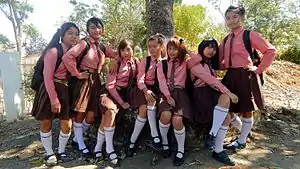
Education policy is prepared by the Central Government and State Governments at national and state levels respectively. The National Policy on Education (NPE), 1986, has provided for environment awareness, science and technology education, and introduction of traditional elements such as Yoga into the Indian secondary school system.[27] A significant feature of India's secondary school system is the emphasis on inclusion of the disadvantaged sections of the society. Professionals from established institutes are often called to support in vocational training. Another feature of India's secondary school system is its emphasis on profession based vocational training to help students attain skills for finding a vocation of his/her choosing.[28] A significant new feature has been the extension of SSA to secondary education in the form of the Rashtriya Madhyamik Shiksha Abhiyan.[29]
Curriculum and school education boards
School boards set the curriculum, conduct board level exams mostly at 10th and 12th level to award the school diplomas. Exams at the remaining levels (also called standard, grade or class, denoting the years of schooling) are conducted by the schools.
- National Council of Educational Research and Training (NCERT): The NCERT is the apex body located at New Delhi, Capital City of India. It makes the curriculum related matters for school education across India.[30] The NCERT provides support, guidance and technical assistance to a number of schools in India and oversees many aspects of enforcement of education policies.[31] There are other curriculum bodies governing school education system specially at state level.
- State government boards of education: Most of the state governments have at least one "State board of secondary school education". However, some states like Andhra Pradesh have more than one. Also the union territories do not have a board. Chandigarh, Dadra and Nagar Haveli, Daman and Diu, and Lakshadweep and Puducherry Lakshadweep share the services with a larger state. The boards set curriculum from Grades 1 to 12 and the curriculum varies from state to state and has more local appeal with examinations conducted in regional languages in addition to English - often considered less rigorous than central curriculums such as CBSE or ICSE/ISC. Most of these conduct exams at 10th and 12th level, but some even at the 5th, 6th and 8th level.
- Central Board of Secondary Education (CBSE): The CBSE sets curriculum from Grades 1 to 12 and conducts examinations at the 10th and 12th standards that are called board exams. Students studying the CBSE Curriculum take the All India Secondary School Examination (AISSE) at the end of grade 10 and All India Senior School Certificate Examination (AISSCE) at the end of grade 12. Examinations are offered in Hindi and English.
- Council for the Indian School Certificate Examinations (CISCE): CISCE sets curriculum from Grades 1 to 12 and conducts three examinations, namely, the Indian Certificate of Secondary Education (ICSE - Class/Grade 10); The Indian School Certificate (ISC - Class/Grade 12) and the Certificate in Vocational Education (CVE - Class/Grade 12). CISCE English level has been compared to UK's A-Levels; this board offers more choices of subjects. CBSE exams at grade 10 and 12 have often been compared with ICSE and ISC examinations. ICSE is generally considered to be more rigorous than the CBSE AISSE (grade 10) but the CBSE AISSCE and ISC examinations are almost on par with each other in most subjects with ISC including a slightly more rigorous English examination than the CBSE 12th grade examination. The CBSE and ISC are recognised internationally and most universities abroad accept the final results of CBSE and ISC exams for admissions purposes and as proof of completion of secondary school.
- National Institute of Open Schooling (NIOS): The NIOS conducts two examinations, namely, Secondary Examination and Senior Secondary Examination (All India) and also some courses in Vocational Education. National Board of education is run by Government of India's HRD Ministry to provide education in rural areas and challenged groups in open and distance education mode. A pilot project started by CBSE to provide high class affordable education, provides education up to 12th standard. Choice of subjects is highly customisable and equivalent to CBSE. Home-schooled students usually take NIOS or international curriculum examinations as they are ineligible to write CBSE or ISC exams.
- Islamic madrasah: Their boards are controlled by local state governments, or autonomous, or affiliated with Darul Uloom Deoband or Darul Uloom Nadwtul Ulama.
- Autonomous schools: Such as Woodstock School, Sri Aurobindo International Centre of Education Puducherry, Patha Bhavan and Ananda Marga Gurukula.
- International Baccalaureate (IB) and Cambridge International Examinations (CIB): These are generally private schools that have dual affiliation with one of the school education board of India as well as affiliated to the International Baccalaureate (IB) Programme and/or the Cambridge International Examinations (CIB).
- International schools, which offer 10th and 12th standard examinations under the International Baccalaureate, Cambridge Senior Secondary Examination systems or under their home nations school boards (such as run by foreign embassies or the expat communities).
- Special education: A special Integrated Education for Disabled Children (IEDC) programme was started in 1974 with a focus on primary education.[30] but which was converted into Inclusive Education at Secondary Stage[32]
Midday Meal Scheme
.jpg.webp)
The Midday Meal Scheme is a school meal programme of the Government of India designed to improve the nutritional status of school-age children nationwide,[33] by supplying free lunches on working days for children in primary and upper primary classes in government, government aided, local body, Education Guarantee Scheme, and alternative innovative education centres, Madarsa and Maqtabs supported under Sarva Shiksha Abhiyan, and National Child Labour Project schools run by the ministry of labour.[34] Serving 120,000,000 children in over 1,265,000 schools and Education Guarantee Scheme centres, it is the largest such programme in the world.[35]
Teacher Training
In addition, NUEPA (National University of Educational Planning and Administration)[36] and NCTE (National Council for Teacher Education) are responsible for the management of the education system and teacher accreditation.[37]
Pre-primary education
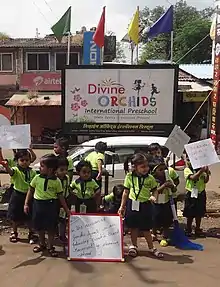
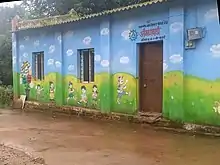
The pre-primary stage is the foundation of children's knowledge, skills and behaviour. On completion of pre-primary education, the children are sent to the primary stage but pre-primary education in India is not a fundamental right. In rural India, pre-primary schools are rarely available in small villages. But in cities and big towns, there are many established players in the pre-primary education sector. The demand for the preschools is growing considerably in the smaller towns and cities but still, only 1% of the population under age 6 is enrolled in preschool education.
- Play group (pre-nursery): At playschools, children are exposed to a lot of basic learning activities that help them to get independent faster and develop their self-help qualities like eating food themselves, dressing up, and maintaining cleanliness. The age limit for admission into pre-nursery is 2 to 3 years. Anganwadi is government-funded free rural childcare & Mothercare nutrition and learning program also incorporating the free Midday Meal Scheme.[38]
- Nursery: Nursery level activities help children unfold their talents, thus enabling them to sharpen their mental and physical abilities. The age limit for admission in nursery is 3 to 4 years.
- LKG: It is also called the junior kindergarten (Jr. kg) stage. The age limit for admission in LKG is 4 to 5 years.
- UKG: It is also called the senior kindergarten (Sr. kg) stage. The age limit for admission in UKG is 5 to 6 years.
LKG and UKG stages prepare and help children emotionally, mentally, socially and physically to grasp knowledge easily in the later stages of school and college life. [39] A systematic process of preschool education is followed in India to impart knowledge in the best possible way for a better understanding of the young children. By following an easy and interesting curriculum, teachers strive hard to make the entire learning process enjoyable for the children.
Primary education
The primary education in India is divided into two parts, namely Lower Primary (Class I-IV) and Upper Primary (Middle school, Class V-VIII). The Indian government lays emphasis on primary education (Class I-VIII) also referred to as elementary education, to children aged 6 to 14 years old.[40] Because education laws are given by the states, duration of primary school visit alters between the Indian states. The Indian government has also banned child labour in order to ensure that the children do not enter unsafe working conditions.[40] However, both free education and the ban on child labour are difficult to enforce due to economic disparity and social conditions.[40] 80% of all recognised schools at the elementary stage are government run or supported, making it the largest provider of education in the country.[41]
However, due to a shortage of resources and lack of political will, this system suffers from massive gaps including high pupil to teacher ratios, shortage of infrastructure and poor levels of teacher training. Figures released by the Indian government in 2011 show that there were 5,816,673 elementary school teachers in India.[42] As of March 2012 there were 2,127,000 secondary school teachers in India.[43] Education has also been made free[40] for children for 6 to 14 years of age or up to class VIII under the Right of Children to Free and Compulsory Education Act 2009.[44]
There have been several efforts to enhance quality made by the government. The District Education Revitalisation Programme (DERP) was launched in 1994 with an aim to universalise primary education in India by reforming and vitalising the existing primary education system.[45] 85% of the DERP was funded by the central government and the remaining 15% was funded by the states.[45] The DERP, which had opened 160,000 new schools including 84,000 alternative education schools delivering alternative education to approximately 3.5 million children, was also supported by UNICEF and other international programmes.[45] In January 2016, Kerala became the 1st Indian state to achieve 100% primary education through its literacy programme Athulyam.[46]
This primary education scheme has also not shown a high gross enrollment ratio of 93–95% for the last three years in some states.[45] Significant improvement in staffing and enrolment of girls has also been made as a part of this scheme.[45] The current scheme for universalisation of Education for All is the Sarva Shiksha Abhiyan which is one of the largest education initiatives in the world. Enrollment has been enhanced, but the levels of quality remain low.
Secondary education
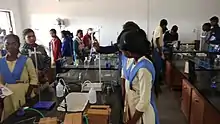
.jpg.webp)
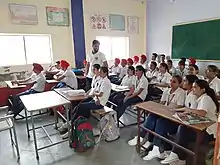
Secondary education covers children aged 14 to 18, a group comprising 88.5 million children according to the 2001 Census of India. The final two years of secondary is often called Higher Secondary (HS), Senior Secondary, or simply the "+2" stage. The two-halves of secondary education are each an important stage for which a pass certificate is needed, and thus are affiliated by central boards of education under HRD ministry, before one can pursue higher education, including college or professional courses.
UGC, NCERT, CBSE and ICSE directives state qualifying ages for candidates who wish to take board exams. Those at least 15 years old by 30 May for a given academic year are eligible to appear for Secondary board exams, and those 17 by the same date are eligible to appear for Higher Secondary certificate board exams. It further states that upon successful completion of Higher Secondary, one can apply to higher education under UGC control such as Engineering, Medical, and Business administration.
Secondary education in India is examination-oriented and not course-based: students register for and take classes primarily to prepare for one of the centrally-administered examinations. Senior school or high school is split into 2 parts (grades 9-10 and grades 11–12) with a standardised nationwide examination at the end of grade 10 and grade 12 (usually informally referred to as "board exams"). Grade 10 examination results can be used for admission into grades 11–12 at a secondary school, pre-university program, or a vocational or technical school. Passing a grade 12 board examination leads to the granting of a secondary school completion diploma, which may be used for admission into vocational schools or universities in the country or the world. Most reputable universities in India require students to pass college-administered admissions tests in addition to passing a final secondary school examination for entry into a college or university. School grades are usually not sufficient for college admissions in India.
Most schools in India do not offer subject and scheduling flexibility due to budgeting constraints (for e.g.: most students in India are not allowed to take Chemistry and History in grades 11-12 because they are part of different "streams"). Private candidates (i.e. not studying in a school) are generally not allowed to register for and take board examinations but there are some exceptions such as NIOS.
10th (matriculation or secondary) exam
Students taking the grade 10 examination usually take six subjects: English, mathematics, social studies, science, one language, and one optional subject depending on the availability of teachers. Elective or optional subjects often include computer applications, economics, physical education, commerce, and environmental science.
12th (senior secondary or higher secondary) exam
Students taking the grade 12 examination usually take four or five subjects with English or the local language being compulsory. Students re-enrolling in most secondary schools after grade 10 have to make the choice of choosing a "core stream" in addition to English or the local language: science (mathematics/biology, chemistry, and physics), commerce (accounts, business studies, and economics), or humanities (any three of history, political science, sociology, psychology, geography depending on school). Students study mathematics up to single-variable calculus in grade 12.
Government schools
The majority of students study in government schools where poor and vulnerable students study for free until the age of 14. An Education Ministry data, 65.2% (113 million,) of all school students in 20 states go to government schools (c. 2017).[47] These include schools runs by the state and local government as well as the centre government. Example of large centre government run school systems are Kendriya Vidyalaya in urban areas, Jawahar Navodaya Vidyalaya, for the gifted students, Kasturba Gandhi Balika Vidyalaya for girls belonging to vulnerable SC/ST/OBC classes, Indian Army Public Schools run by the Indian Army for the children of soldiers.
Kendriya Vidyalaya project, was started for the employees of the central government of India, who are deployed throughout the country. The government started the Kendriya Vidyalaya project in 1965 to provide uniform education in institutions following the same syllabus at the same pace regardless of the location to which the employee's family has been transferred.[30]
Government aided private schools
These are usually charitable trust run schools that receive partial funding from the government. Largest system of aided schools is run by D.A.V. College Managing Committee.
Private schools (unaided)
According to current estimate, 29% of Indian children are privately educated.[10] With more than 50% children enrolling in private schools in urban areas, the balance has already tilted towards private schooling in cities; and, even in rural areas, nearly 20% of the children in 2004-5 were enrolled in private schools.[48]
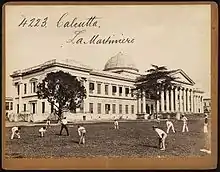
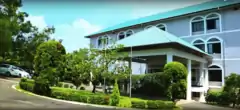
Most middle-class families send their children to private schools,[48] which might be in their own city or at distant boarding schools. Private schools have been established since the British Rule in India and St George's School, Chennai is the oldest private school in India.[49] At such schools, the medium of education is often English, but Hindi and/or the state's official language is also taught as a compulsory subject.[50] Pre-school education is mostly limited to organised neighbourhood nursery schools with some organised chains. Montessori education is also popular, due to Maria Montessori's stay in India during World War II. In 2014, four of the top ten pre-schools in Chennai were Montessori.[51]
Many privately owned and managed schools carry the appellation "Public", such as the Delhi Public Schools, or Frank Anthony Public Schools. These are modelled after British public schools, which are a group of older, expensive and exclusive fee-paying private independent schools in England.
According to some research, private schools often provide superior results at a multiple of the unit cost of government schools. The reason being high aims and better vision.[52][53][54] However, others have suggested that private schools fail to provide education to the poorest families, a selective being only a fifth of the schools and have in the past ignored Court orders for their regulation.
In their favour, it has been pointed out that private schools cover the entire curriculum and offer extra-curricular activities such as science fairs, general knowledge, sports, music and drama.[55] The pupil teacher ratios are much better in private schools (1:31 to 1:37 for government schools) and more teachers in private schools are female. There is some disagreement over which system has better educated teachers. According to the latest DISE survey, the percentage of untrained teachers (para-teachers) is 54.91% in private, compared to 44.88% in government schools and only 2.32% teachers in unaided schools receive in-service training compared to 43.44% for government schools. The competition in the school market is intense, yet most schools make profit.[55] However, the number of private schools in India is still low - the share of private institutions is 7% (with upper primary being 21% secondary 32% - source: fortress team research). Even the poorest often go to private schools despite the fact that government schools are free. A study found that 65% school-children in Hyderabad's slums attend private schools.[54]
National schools
- Atomic Energy Central School (established in 1969)
- Bal Bharati Public School (established in 1944)
- Bharatiya Vidya Bhavan (established in 1938)
- Chinmaya Vidyalaya (established in 1965)
- DAV Public School (established in 1886)
- Delhi Public School (established in 1949)
- Indian Army Public Schools (established in 1983)
- Jawahar Navodaya Vidyalaya (established in 1986)
- Kendriya Vidyalaya (established in 1963)
- Padma Seshadri Bala Bhavan (established in 1958)
- Railway Schools in India (established in 1873)
- Ramakrishna Mission Schools[57][58][59][60] (established in 1922)
- Ryan International Schools (established in 1976)
- Sainik School (established in 1960)
- Saraswati Shishu Mandir (established in 1952)
- Seth M.R. Jaipuria Schools (established in 1992)
- Vivekananda Vidyalaya (established in 1972)
- Vivekananda Kendra Vidyalaya (established in 1977)
- Waldorf Schools (India) (established in 2002)
International schools
As of January 2015, the International Schools Consultancy (ISC)[61] listed India as having 410 international schools.[62] ISC defines an 'international school' in the following terms "ISC includes an international school if the school delivers a curriculum to any combination of pre-school, primary or secondary students, wholly or partly in English outside an English-speaking country, or if a school in a country where English is one of the official languages, offers an English-medium curriculum other than the country's national curriculum and is international in its orientation."[62] This definition is used by publications including The Economist.[63]
Home-schooling
Home-schooling in India is legal, though it is the less explored option, and often debated by educators. The Indian Government's stance on the issue is that parents are free to teach their children at home, if they wish to and have the means. The then HRD Minister Kapil Sibal has stated that despite the RTE Act of 2009, if someone decides not to send his/her children to school, the government would not interfere.[64]
Higher education
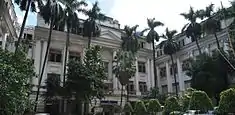
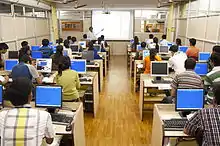
Students may opt for vocational education or university education.
Vocational education
India's All India Council of Technical Education (AICTE) reported, in 2013, that there are more than 4,599 vocational institutions that offer degrees, diploma and post-diploma in architecture, engineering, hotel management, infrastructure, pharmacy, technology, town services and others. There were 1740,000 students enrolled in these schools.[65] Total annual intake capacity for technical diplomas and degrees exceeded 3.4 million in 2012.
According to the University Grants Commission (UGC) total enrolment in Science, Medicine, Agriculture and Engineering crossed 65 lakh in 2010. The number of women choosing engineering has more than doubled since 2001.
Tertiary education
After passing the Higher Secondary Examination (the Standard 12 examination), students may enroll in general degree programmes such as bachelor's degree (graduation) in arts, commerce or science, or professional degree programme such as engineering, medicine, nursing, pharmacy, and law graduates.[66] India's higher education system is the third largest in the world, after China and the United States.[67] The main governing body at the tertiary level is the University Grants Commission (India) (UGC), which enforces its standards, advises the government, and helps co-ordinate between the centre and the state up to Post graduation and Doctorate (PhD).[68] Accreditation for higher learning is overseen by 12 autonomous institutions established by the University Grants Commission.[69]
As of 2012, India has 152[70] central universities, 316 state universities, and 191 private universities. Other institutions include 33,623[71] colleges, including 1,800 exclusive women's colleges, functioning under these universities and institutions,[68] and 12,748 Institutions offering Diploma Courses. The emphasis in the tertiary level of education lies on science and technology.[72] Indian educational institutions by 2004 consisted of a large number of technology institutes.[73] Distance learning is also a feature of the Indian higher education system.[73] The Government has launched Rashtriya Uchchattar Shiksha Abhiyan to provide strategic funding to State higher and technical institutions. A total of 316 state public universities and 13,024 colleges will be covered under it.[74]
Some institutions of India, such as the Indian Institutes of Technology (IITs) and National Institutes of Technology (NITs) have been globally acclaimed for their standard of under-graduate education in engineering. Several other institutes of fundamental research such as the Indian Institute of Science (IISc) Indian Association for the Cultivation of Science (IACS), Tata Institute of Fundamental Research (TIFR), Harish-Chandra Research Institute (HRI), Indian Institute of Science Education and Research (IISER) are also acclaimed for their standard of research in basic sciences and mathematics. However, India has failed to produce world class universities both in the private sector or the public sector.[75]
Besides top rated universities which provide highly competitive world class education to their pupils, India is also home to many universities which have been founded with the sole objective of making easy money. Regulatory authorities like UGC and AICTE have been trying very hard to extirpate the menace of private universities which are running courses without any affiliation or recognition. Indian Government has failed to check on these education shops, which are run by big businessmen & politicians. Many private colleges and universities do not fulfil the required criterion by the Government and central bodies (UGC, AICTE, MCI, BCI etc.) and take students for a ride. For example, many institutions in India continue to run unaccredited courses as there is no legislation strong enough to ensure legal action against them. Quality assurance mechanisms have failed to stop misrepresentations and malpractices in higher education. At the same time regulatory bodies have been accused of corruption, specifically in the case of deemed-universities.[76] In this context of lack of solid quality assurance mechanism, institutions need to step-up and set higher standards of self-regulation.[77]
Our university system is, in many parts, in a state of disrepair...In almost half the districts in the country, higher education enrollments are abysmally low, almost two-third of our universities and 90% of our colleges are rated as below average on quality parameters... I am concerned that in many states university appointments, including that of vice-chancellors, have been politicised and have become subject to caste and communal considerations, there are complaints of favouritism and corruption.
The Government of India is aware of the plight of higher education sector and has been trying to bring reforms, however, 15 bills are still awaiting discussion and approval in the Parliament.[79] One of the most talked about bill is Foreign Universities Bill, which is supposed to facilitate entry of foreign universities to establish campuses in India. The bill is still under discussion and even if it gets passed, its feasibility and effectiveness is questionable as it misses the context, diversity and segment of international foreign institutions interested in India.[80] One of the approaches to make internationalisation of Indian higher education effective is to develop a coherent and comprehensive policy which aims at infusing excellence, bringing institutional diversity and aids in capacity building.[81]
Three Indian universities were listed in the Times Higher Education list of the world's top 200 universities – Indian Institutes of Technology, Indian Institutes of Management, and Jawaharlal Nehru University in 2005 and 2006.[82] Six Indian Institutes of Technology and the Birla Institute of Technology and Science—Pilani were listed among the top 20 science and technology schools in Asia by Asiaweek.[83] The Indian School of Business situated in Hyderabad was ranked number 12 in global MBA rankings by the Financial Times of London in 2010[84] while the All India Institute of Medical Sciences has been recognised as a global leader in medical research and treatment.[85] The University of Mumbai was ranked 41 among the Top 50 Engineering Schools of the world by America's news broadcasting firm Business Insider in 2012 and was the only university in the list from the five emerging BRICS nations viz Brazil, Russia, India, China and South Africa.[86] It was ranked at 62 in the QS BRICS University rankings for 2013[87] and was India's 3rd best Multi-Disciplinary University in the QS University ranking of Indian Universities after University of Calcutta and Delhi University.[88] In April 2015, IIT Bombay launched the first U.S.-India joint EMBA program alongside Washington University in St. Louis.[89]
Technical education
From the first Five-year Plan onwards, India's emphasis was to develop a pool of scientifically inclined manpower.[90] India's National Policy on Education (NPE) provisioned for an apex body for regulation and development of higher technical education, which came into being as the All India Council for Technical Education (AICTE) in 1987 through an act of the Indian parliament.[91] At the federal level, the Indian Institutes of Technology, the Indian Institute of Space Science and Technology, the National Institutes of Technology and the Indian Institutes of Information Technology are deemed of national importance.[91]
The Indian Institutes of Technology (IITs) and National Institutes of Technology (NITs) are among the nation's premier education facilities.[91]
[91] The UGC has inter-university centres at a number of locations throughout India to promote common research, e.g. the Nuclear Science Centre at the Jawaharlal Nehru University, New Delhi.[92] Besides there are some British established colleges such as Harcourt Butler Technological Institute situated in Kanpur and King George Medical University situated in Lucknow which are important centre of higher education.
In addition to above institutes, efforts towards the enhancement of technical education are supplemented by a number of recognised Professional Engineering Societies such as:
- Institution of Engineers (India)
- Institution of Civil Engineers (India)
- Institution of Mechanical Engineers (India)
- Institution of Chemical Engineering (India)
- Institution of Electronics and Tele-Communication Engineers (India)
- Indian Institute of Metals
- Institution of Industrial Engineers (India)
- Institute of Town Planners (India)
- Indian Institute of Architects
that conduct Engineering/Technical Examinations at different levels (Degree and diploma) for working professionals desirous of improving their technical qualifications.
The number of graduates coming out of technical colleges increased to over 700,000 in 2011 from 550,000 in FY 2010.[93][94] However, according to one study, 75% of technical graduates and more than 85% of general graduates lack the skills needed in India's most demanding and high-growth global industries such as Information Technology.[95] These high-tech global information technologies companies directly or indirectly employ about 2.3 million people, less than 1% of India's labour pool.[96] India offers one of the largest pool of technically skilled graduates in the world. Given the sheer numbers of students seeking education in engineering, science and mathematics, India faces daunting challenges in scaling up capacity while maintaining quality.[97][98]
Open and distance learning
At the school level, Board of Open Schooling and Skill Education, Sikkim (BOSSE), National Institute of Open Schooling (NIOS) provides opportunities for continuing education to those who missed completing school education. 1.4 million students are enrolled at the secondary and higher secondary level through open and distance learning.[99] In 2012 various state governments also introduced "State Open School" to provide distance education.[100]
At higher education level, Indira Gandhi National Open University (IGNOU) co-ordinates distance learning. It has a cumulative enrolment of about 1.5 million, serviced through 53 regional centres and 1,400 study centres with 25,000 counselors. The Distance Education Council (DEC), an authority of IGNOU is co-co-ordinating 13 State Open Universities and 119 institutions of correspondence courses in conventional universities. While distance education institutions have expanded at a very rapid rate, but most of these institutions need an up gradation in their standards and performance. There is a large proliferation of courses covered by distance mode without adequate infrastructure, both human and physical. There is a strong need to correct these imbalances.[101]
Massive open online course are made available for free by the HRD ministry and various educational institutes.
Quality
Literacy
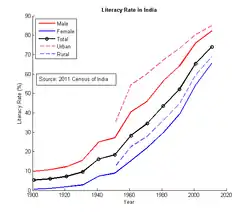
According to the Census of 2011, "every person above the age of 7 years who can read and write with understanding in any language is said to be literate". According to this criterion, the 2011 survey holds the national literacy rate to be 74.04%.[102] The youth literacy rate, measured within the age group of 15 to 24, is 81.1% (84.4% among males and 74.4% among females),[103] while 86% of boys and 72% of girls are literate in the 10-19 age group.[104]
Within the Indian states, Kerala has the highest literacy rate of 93.91% whereas Bihar averaged 61.8% literacy.[102] The 2001 statistics indicated that the total number of 'absolute non-literates' in the country was 304 million.[102] Gender gap in literacy rate is high, for example in Rajasthan, the state with the lowest female literacy rate in India,[105] average female literacy rate is 52.66% and average male literacy rate is 80.51%, making a gender gap of 27.85%.[106]
Attainment
As of 2011, enrolment rates are 58% for pre-primary, 93% for primary, 69% for secondary, and 25% for tertiary education.[107]
Despite the high overall enrolment rate for primary education among rural children of age 10, half could not read at a basic level, over 60% were unable to do division, and half dropped out by the age of 14.[108]
In 2009, two states in India, Tamil Nadu and Himachal Pradesh, participated in the international PISA exams which is administered once every three years to 15-year-old's. Both states ranked at the bottom of the table, beating out only Kyrgyzstan in score, and falling 200 points (two standard deviations) below the average for OECD countries.[109] While in the immediate aftermath there was a short-lived controversy over the quality of primary education in India, ultimately India decided to not participate in PISA for 2012,[110] and again not to for 2015.[111]
While the quality of free, public education is in crisis, a majority of the urban poor have turned to private schools. In some urban cities, it is estimated as high as two-thirds of all students attend private institutions,[112] many of which charge a modest US$2 per month.
Public school workforce
Officially, the pupil to teacher ratio within the public school system for primary education is 35:1.[113] However, teacher absenteeism in India is exorbitant, with 25% never showing up for work.[114] The World Bank estimates the cost in salaries alone paid toNO-Show teachers who have never attended work is US$2 billion per year.[115]
A study on teachers by Kremer etc. found out that 25% of private sector teachers and 40% of public sector medical workers were absent during the survey. Among teachers who were paid to teach, absence rates ranged from 14.6% in Maharashtra to 41.9% in Jharkhand. Only 1 in nearly 3,000 public school head teachers had ever dismissed a teacher for repeated absence.[116] The same study found "only about half were teaching, during unannounced visits to a nationally representative sample of government primary schools in India."[116]
Higher education
As per Report of the Higher education in India, Issues Related to Expansion, Inclusiveness, Quality and Finance,[117] the access to higher education measured in term of gross enrolment ratio increased from 0.7% in 1950/51 to 1.4% in 1960–61. By 2006/7 the GER increased to about 11%. Notably, by 2012, it had crossed 20% (as mentioned in an earlier section).
According to a survey by All India Survey on Higher Education (AISHE) released by the ministry of human resource development, Tamil Nadu which has the highest gross enrollment ratio (GER) in higher education in the country has registered an increase of 2.6% to take GER to 46.9 per cent in 2016–17.[118]
Vocational education
An optimistic estimate from 2008 was that only one in five job-seekers in India ever had any sort of vocational training.[119] However it's expected to grow as the CBSE has brought changes in its education system which emphasises inclusion of certain number and types of vocational subjects in classes 9th and 11th. Although it's not mandatory for schools to go for it but a good number of schools have voluntarily accepted the suggestion and incorporated the change in their curriculum.
Extracurricular activities
Extracurricular activities include sports, arts, National Service Scheme, National Cadet Corps, The Bharat Scouts and Guides, etc.
Issues
Facilities
As per 2016 Annual Survey of Education Report (ASER), 3.5% schools in India had no toilet facility while only 68.7% schools had usable toilet facility. 75.5% of the schools surveyed had library in 2016, a decrease from 78.1% in 2014. Percentage of schools with separate girls toilet have increased from 32.9% in 2010 to 61.9%in 2016.[120] 74.1% schools had drinking water facility and 64.5% of the schools had playground.[121]
Curriculum issues
Modern education in India is often criticised for being based on rote learning rather than problem solving. New Indian Express says that Indian Education system seems to be producing zombies since in most of the schools students seemed to be spending majority of their time in preparing for competitive exams rather than learning or playing.[122] BusinessWeek criticises the Indian curriculum, saying it revolves around rote learning[123] and ExpressIndia suggests that students are focused on cramming.[124] Preschool for Child Rights states that almost 99% of pre-schools do not have any curriculum at all.[125] Also creativity is not encouraged or is considered as a form of entertainment in most institutions.[126]
Rural education
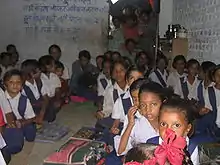
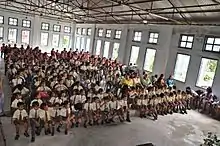
Following independence, India viewed education as an effective tool for bringing social change through community development.[127] The administrative control was effectively initiated in the 1950s, when, in 1952, the government grouped villages under a Community Development Block—an authority under national programme which could control education in up to 100 villages.[127] A Block Development Officer oversaw a geographical area of 150 square miles (390 km2) which could contain a population of as many as 70,000 people.[127]
Setty and Ross elaborate on the role of such programmes, themselves divided further into individual-based, community based, or the Individual-cum-community-based, in which microscopic levels of development are overseen at village level by an appointed worker:
The community development programmes comprise agriculture, animal husbandry, cooperation, rural industries, rural engineering (consisting of minor irrigation, roads, buildings), health and sanitation including family welfare, family planning, women welfare, child care and nutrition, education including adult education, social education and literacy, youth welfare and community organisation. In each of these areas of development there are several programmes, schemes and activities which are additive, expanding and tapering off covering the total community, some segments, or specific target populations such as small and marginal farmers, artisans, women and in general people below the poverty line.[127]
Despite some setbacks the rural education programmes continued throughout the 1950s, with support from private institutions.[128] A sizeable network of rural education had been established by the time the Gandhigram Rural Institute was established and 5,200 Community Development Blocks were established in India.[129] Nursery schools, elementary schools, secondary school, and schools for adult education for women were set up.[129]
The government continued to view rural education as an agenda that could be relatively free from bureaucratic backlog and general stagnation.[129] However, in some cases lack of financing balanced the gains made by rural education institutes of India.[130] Some ideas failed to find acceptability among India's poor and investments made by the government sometimes yielded little results.[130] Today, government rural schools remain poorly funded and understaffed. Several foundations, such as the Rural Development Foundation (Hyderabad), actively build high-quality rural schools, but the number of students served is small.
Education in rural India is valued differently from in an urban setting, with lower rates of completion. An imbalanced sex ratio exists within schools with 18% of males earning a high school diploma compared with only 10% of females. The estimated number of children who have never attended school in India is near 100 million which reflects the low completion levels. This is the largest concentration in the world of youth who haven't enrolled in school.[131][132][133][134]
Women's education
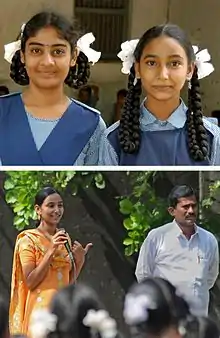
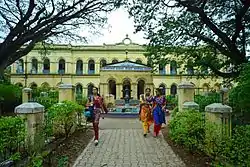
Women have a much lower literacy rate than men. Far fewer girls are enrolled in the schools, and many of them drop out.[136] In the patriarchal setting of the Indian family, girls have lower status and fewer privileges than boys.[137] Conservative cultural attitudes prevent some girls from attending school.[138] Furthermore, educated high class women are less likely than uneducated low class women to enter the workforce They opt to stay at home due to the traditional, cultural and religious norms.[139]
The number of literate women among the female population of India was between 2–6% from the British Raj onwards to the formation of the Republic of India in 1947.[140] Concerted efforts led to improvement from 15.3% in 1961 to 28.5% in 1981.[140] By 2001 literacy for women had exceeded 50% of the overall female population, though these statistics were still very low compared to world standards and even male literacy within India.[141] Recently the Indian government has launched Saakshar Bharat Mission for Female Literacy. This mission aims to bring down female illiteracy by half of its present level.
Sita Anantha Raman outlines the progress of women's education in India:
Since 1947 the Indian government has tried to provide incentives for girls' school attendance through programmes for midday meals, free books, and uniforms. This welfare thrust raised primary enrollment between 1951 and 1981. In 1986 the National Policy on Education decided to restructure education in tune with the social framework of each state, and with larger national goals. It emphasised that education was necessary for democracy, and central to the improvement of women's condition. The new policy aimed at social change through revised texts, curricula, increased funding for schools, expansion in the numbers of schools, and policy improvements. Emphasis was placed on expanding girls' occupational centres and primary education; secondary and higher education; and rural and urban institutions. The report tried to connect problems like low school attendance with poverty, and the dependence on girls for housework and sibling day care. The National Literacy Mission also worked through female tutors in villages. Although the minimum marriage age is now eighteen for girls, many continue to be married much earlier. Therefore, at the secondary level, female drop-out rates are high.[142]
Sita Anantha Raman also mentions that while the educated Indian women workforce maintains professionalism, the men outnumber them in most fields and, in some cases, receive higher income for the same positions.[142]
The education of women in India plays a significant role in improving livings standards in the country. A higher female literacy rate improves the quality of life both at home and outside the home, by encouraging and promoting education of children, especially female children, and in reducing the infant mortality rate. Several studies have shown that a lower level of women literacy rates results in higher levels of fertility and infant mortality, poorer nutrition, lower earning potential and the lack of an ability to make decisions within a household.[143] Women's lower educational levels is also shown to adversely affect the health and living conditions of children. A survey that was conducted in India showed results which support the fact that infant mortality rate was inversely related to female literacy rate and educational level.[144] The survey also suggests a correlation between education and economic growth.
In India, there is a large disparity between female literacy rates in different states.[145] State of Kerala has the highest female literacy rate of 91.98% while Rajasthan has the lowest female literacy rate of 52.66.[146][147] This correlates to the health levels of states, Kerala has average life expectancy at birth of 74.9 while Rajasthan's average life expectancy at birth is 67.7 years.[148]
In India, higher education is defined as the education of an age group between 18 and 24, and is largely funded by the government. Despite women making up 24–50% of higher education enrolment, there is still a gender imbalance within higher education. Only one third of science students and 7% of engineering students, are women. In comparison, however, over half the students studying Education are women.[149]
Accreditation
In January 2010, the Government of India decided to withdraw Deemed university status from as many as 44 institutions. The Government claimed in its affidavit that academic considerations were not being kept in mind by the management of these institutions and that "they were being run as family fiefdoms".[150]
In February 2009, the University Grant Commission found 39 fake institutions operating in India.[151]
Employer training
Only 10% of manufacturers in India offer in-service training to their employees, compared with over 90% in China.[152]
Teacher careers
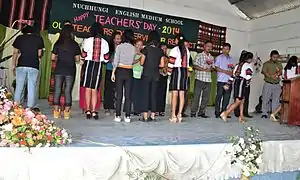
In the Indian education system, a teacher's success is loosely defined. It is either based on a student's success or based on the years of teaching experience, both of which do not necessarily correlate to a teacher's skill set or competencies. The management of an institution could thereby be forced to promote teachers based on the grade level they teach or their seniority, both of which are often not an indicator of a good teacher.[153] This means that either a primary school teacher is promoted to a higher grade, or a teacher is promoted to take up other roles within the institution such as Head of Department, coordinator, Vice Principal or Principal. However, the skills and competencies that are required for each of them vary and a great teacher may not be a great manager. Since teachers do not see their own growth and success in their own hands, they often do not take up any professional development. Thus, there is a need to identify a framework to help a teacher chart a career path based on his/her own competency and help him/her understand his/her own development.[154]
Coaching
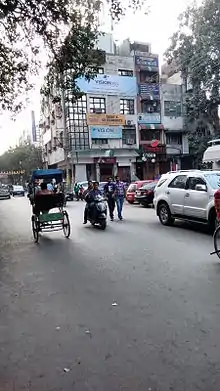
Increased competition to get admission in reputed colleges has given rise to private coaching institutes in India. They prepare students for engineering, medical, MBA, SAT, GRE, banking jobs' entrance tests. There are also coaching institutes that teach subjects like English for employment in India and abroad.
Private coaching institutes are of two types: offline coaching and online coaching. There are many online coaching centres and apps available in the market and their usage is growing, especially in tier 2 metro cities.[155]
A 2013 survey by ASSOCHAM predicted the size of private coaching industry to grow to $40 billion, or Rs 2.39 trillion (short scale) by 2015.[156]
Kota in Rajasthan is the called the capital of engineering and medical colleges' entrance's coaching sector.[156] In Punjab, English language is taught by coaching institutes for foreign visa aspirants to get the right IELTS score for their applications.[157] Mukherjee Nagar and Old Rajinder Nagar in Delhi are considered the hub for UPSC Civil Services Examination coaching.[158] To compete in these exams, Center and some state governments also provide free coaching to students, especially to students from minority communities.[159]
Coaching classes have been blamed for the neglect of school education by students.[160] Educationists such as Anandakrishnan have criticised the increasing importance being given to coaching classes as they put students under mental stress and the coaching fees add to the financial burden on parents. These educationists opine that if a good schooling system is put in place, children should not need additional coaching to take any competitive examination.[161]
Corruption in education
Corruption in Indian education system has been eroding the quality of education and has been creating long-term negative consequences for the society. Educational corruption in India is considered as one of the major contributors to domestic black money.[162]
Grade inflation
Grade inflation has become an issue in Indian secondary education. In CBSE, a 95 percent aggregate is 21 times as prevalent today as it was in 2004, and a 90 percent close to nine times as prevalent. In the ISC Board, a 95 percent is almost twice as prevalent today as it was in 2012. CBSE called a meeting of all 40 school boards early in 2017 to urge them to discontinue "artificial spiking of marks". CBSE decided to lead by example and promised not to inflate its results. But although the 2017 results have seen a small correction, the board has clearly not discarded the practice completely. Almost 6.5 percent of mathematics examinees in 2017 scored 95 or more – 10 times higher than in 2004 – and almost 6 percent of physics examinees scored 95 or more, 35 times more than in 2004.[163][164]
Initiatives
Central government involvement
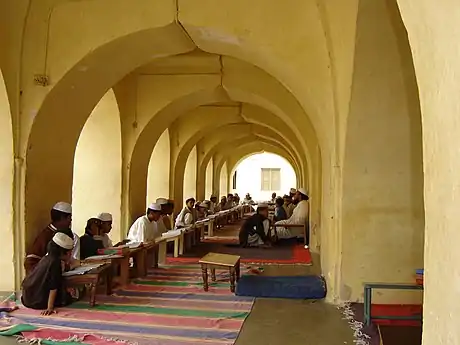
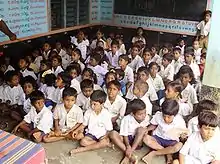
Following India's independence, a number of rules were formulated for the backward Scheduled Castes and the Scheduled Tribes of India. In 1960, a list identifying 405 Scheduled Castes and 225 Scheduled Tribes was published by the central government.[165] An amendment was made to the list in 1975, which identified 841 Scheduled Castes and 510 Scheduled Tribes.[165] The total percentage of Scheduled Castes and Scheduled Tribes combined was found to be 22.5% with the Scheduled Castes accounting for 17% and the Scheduled Tribes accounting for the remaining 7.5%.[165] Following the report many Scheduled Castes and Scheduled Tribes increasingly referred to themselves as Dalit, a Marathi language terminology used by B R Ambedkar which literally means "oppressed".[165]
The Scheduled Castes and Scheduled Tribes are provided for in many of India's educational programmes.[166] Special reservations are also provided for the Scheduled Castes and Scheduled Tribes in India, e.g. a reservation of 15% in Kendriya Vidyalaya for Scheduled Castes and another reservation of 7.5% in Kendriya Vidyalaya for Scheduled Tribes.[166] Similar reservations are held by the Scheduled Castes and Scheduled Tribes in many schemes and educational facilities in India.[166] The remote and far-flung regions of North-East India are provided for under the Non-Lapsible Central pool of Resources (NLCPR) since 1998–1999.[167] The NLCPR aims to provide funds for infrastructure development in these remote areas.[167]
Women from remote, underdeveloped areas or from weaker social groups in Andhra Pradesh, Assam, Bihar, Jharkhand, Karnataka, Kerala, Gujarat, Uttar Pradesh, and Uttarakhand, fall under the Mahila Samakhya Scheme, initiated in 1989.[168] Apart from provisions for education this programme also aims to raise awareness by holding meetings and seminars at rural levels.[168] The government allowed ₹340 million (US$4.8 million) during 2007–08 to carry out this scheme over 83 districts including more than 21,000 villages.[168]
Currently there are 68 Bal Bhavans and 10 Bal Kendra affiliated to the National Bal Bhavan.[169] The scheme involves educational and social activities and recognising children with a marked talent for a particular educational stream.[169] A number of programmes and activities are held under this scheme, which also involves cultural exchanges and participation in several international forums.[169]
India's minorities, especially the ones considered 'educationally backward' by the government, are provided for in the 1992 amendment of the Indian National Policy on Education (NPE).[170] The government initiated the Scheme of Area Intensive Programme for Educationally Backward Minorities and Scheme of Financial Assistance or Modernisation of Madarsa Education as part of its revised Programme of Action (1992).[170] Both these schemes were started nationwide by 1994.[170] In 2004 the Indian parliament passed an act which enabled minority education establishments to seek university affiliations if they passed the required norms.[170]
Ministry of Human Resource and Development, Government of India in collaboration with Ministry of Electronics & Information Technology has also launched a National Scholarship Portal to provide students of India access to National and State Level Scholarships provided by various government authorities. As a Mission Mode Project under the National e-Governance Plan (NeGP), the online service enlists more than 50 scholarship programs every year including the renowned Ministry of Minority Affairs (MOMA) Scholarships for Post-Matric and Pre-Matric studies. In the academic year 2017-18 the MOMA Scholarships facilitated the studies of 116,452 students with scholarships worth ₹3165.7 million.[171] The National Scholarship continues to enlist scholarship programs managed by AICTE (All India Council for Technical Education), UGC (University Grants Commission) and respective state governments.
Legislative framework
Article 45, of the Constitution of India originally stated:
The State shall endeavour to provide, within a period of ten years from the commencement of this Constitution, for free and compulsory education for all children until they complete the age of fourteen years.[172]
This article was a directive principle of state policy within India, effectively meaning that it was within a set of rules that were meant to be followed in spirit and the government could not be held to court if the actual letter was not followed.[173] However, the enforcement of this directive principle became a matter of debate since this principle held obvious emotive and practical value, and was legally the only directive principle within the Indian constitution to have a time limit.[173]
Following initiatives by the Supreme Court of India during the 1990s the 93rd amendment bill suggested three separate amendments to the Indian constitution:[174]
The constitution of India was amended to include a new article, 21A, which read:
The State shall provide free and compulsory education to all children of the age of six to fourteen years in a such manner as the State may, by law, determine.[175]
Article 45 was proposed to be substituted by the article which read:
Provision for early childhood care and education to children below the age of six years: The State shall endeavour to provide early childhood care and education for all children until they complete the age of sixteen years.[175]
Another article, 51A, was to additionally have the clause:
...a parent or guardian [shall] provide opportunities for education to his child or, as the case may be, [a] ward between the age of six to fourteen years.[175]
The bill was passed unanimously in the Lok Sabha, the lower house of the Indian parliament, on 28 November 2001.[176] It was later passed by the upper house—the Rajya Sabha—on 14 May 2002.[176] After being signed by the President of India the Indian constitution was amended formally for the eighty sixth time and the bill came into effect.[176] Since then those between the age of 6–14 have a fundamental right to education.[177]
Article 46 of the Constitution of India holds that:
The State shall promote, with special care, the education and economic interests of the weaker sections of the people, and in particular of the Scheduled Castes and Scheduled Tribes, and shall protect them from social injustice and all forms of social exploitation'.[102]
Other provisions for the Scheduled Castes and Scheduled Tribes can be found in Articles 330, 332, 335, 338–342.[102] Both the 5th and the 6th Schedules of the Constitution also make special provisions for the Scheduled Castes and Scheduled Tribes.[102]
Central government expenditure on education
As a part of the tenth Five-year Plan (2002–2007), the central government of India outlined an expenditure of 65.6% of its total education budget of ₹438 billion (US$6.1 billion) i.e. ₹288 billion (US$4.0 billion) on elementary education; 9.9% i.e. ₹43.25 billion (US$610 million) on secondary education; 2.9% i.e. ₹12.5 billion (US$180 million) on adult education; 9.5% i.e. ₹41.77 billion (US$590 million) on higher education; 10.7% i.e. ₹47 billion (US$660 million) on technical education; and the remaining 1.4% i.e. ₹6.24 billion (US$87 million) on miscellaneous education schemes.[178]
During the Financial Year 2011–12, the Central Government of India has allocated ₹ 38,957 crore for the Department of School Education and Literacy which is the main department dealing with primary education in India. Within this allocation, major share of ₹ 21,000 crore, is for the flagship programme 'Sarva Siksha Abhiyan'. However, budgetary allocation of ₹ 210,000 million is considered very low in view of the officially appointed Anil Bordia Committee recommendation of ₹ 356.59 billion for the year 2011–12. This higher allocation was required to implement the recent legislation 'Right of Children to Free and Compulsory Education Act, 2009. In recent times, several major announcements were made for developing the poor state of affairs in education sector in India, the most notable ones being the National Common Minimum Programme (NCMP) of the United Progressive Alliance (UPA) government. The announcements are; (a) To progressively increase expenditure on education to around 6% of GDP. (b) To support this increase in expenditure on education, and to increase the quality of education, there would be an imposition of an education cess over all central government taxes. (c) To ensure that no one is denied of education due to economic backwardness and poverty. (d) To make right to education a fundamental right for all children in the age group 6–14 years. (e) To universalise education through its flagship programmes such as Sarva Shiksha Abhiyan and Midday Meal Scheme
However, even after five years of implementation of NCMP, not much progress has been seen on this front. Although the country targeted towards devoting 6% share of the GDP towards the educational sector, the performance has definitely fallen short of expectations. Expenditure on education has steadily risen from 0.64% of GDP in 1951–52 to 2.31% in 1970–71 and thereafter reached the peak of 4.26% in 2000–01. However, it declined to 3.49% in 2004–05. There is a definite need to step-up again. As a proportion of total government expenditure, it has declined from around 11.1% in 2000–2001 to around 9.98% during UPA rule, even though ideally it should be around 20% of the total budget. A policy brief issued by [Network for Social Accountability (NSA)][179] titled "[NSA Response to Education Sector Interventions in Union Budget: UPA Rule and the Education Sector][180] " provides significant revelation to this fact. Due to a declining priority of education in the public policy paradigm in India, there has been an exponential growth in the private expenditure on education also. [As per the available information, the private out of pocket expenditure by the working class population for the education of their children in India has increased by around 1150 percent or around 12.5 times over the last decade].[181]
Indian new education policy 2020 (NEP-20)
The new National Education Policy 2020(NEP 2020)introduced by the central government is expected to bring profound changes to education in India. The policy approved by the Union Cabinet of India on 29 July 2020, outlines the vision of India's new education system.[182] The new policy replaces the 1986 National Policy on Education. The policy is a comprehensive framework for elementary education to higher education as well as vocational training in both rural and urban India. The policy aims to transform India's education system by 2021.[183]
Shortly after the release of the policy, the government clarified that no one will be forced to study any particular language and that the medium of instruction will not be shifted from English to any regional language.[184] The language policy in NEP is a broad guideline and advisory in nature; and it is up to the states, institutions, and schools to decide on the implementation.[33] Education in India is a Concurrent List subject.[185]
The major change envisaged by the policy will be in early education where 10+2 format will be replaced by 5+3+3+4 (or 5+3+3+2+2 or 3+2+3+3+2+2).[186] 5+3+3+4 refers to 5 foundational years, whether in an anganwadi, pre-school or balvatika. This is followed by 3 years of preparatory learning from classes 3 to 5. This is followed by a middle stage that is of 3 years length and finally a 4 year secondary stage uptil class 12 or 18 years of age.[187] This model will be implemented as follows:[188][186]
- 1. Foundational Stage
- Pre-primary|Pre-primary schooling (5+)
It divides the foundational stage into two parts (age of 3–8), 3 years of preschool (Anganwadi) and two years of primary classes 1–2. Now students can start their education at age of 3. The focus of studies will be in activity-based learning.
- 2. Preparatory Stage
- Primary school|Primary schooling (3+)
After pre-primary education, students will enter primary education in the age group of 8–11 years, where they will study in classes 3–5. Teachers will put more emphasis on the students; health, analytical skills, mathematical approach, reasoning, logical thinking and creative thinking. Classes will be more engaging and pedantic than book-based learning. It will gradually introduce subjects like speaking, reading, writing, physical education, languages, art, science and mathematics.
- 3. Middle Stage
- Secondary schooling (3+)
From class 6th (age of 11–14 years) onward additional vocational programs will be added. That will provide deeper and practical knowledge in subjects like sciences, mathematics, arts, social sciences, and humanities, etc.
- 4.Senior secondary education|Senior secondary schooling (4)
After completing class 8th, the students will join senior secondary school between 14 and 18 years. It is again subdivided into two parts: classes 9 and 10 covering the first phase while classes 11 and 12 covering the second phase. These 4 years of study are intended to inculcate multidisciplinary study, coupled with depth and critical thinking. Multiple options of subjects will be provided.
See also
- Gender inequality in India
- Gurukula
- List of schools in India
- Macaulayism, historical background to the implementation of English education in India.
- National Translation Mission
- Open access in India
- Two Million Minutes, documentary film
- Dreams Choked, documentary film
Notes
References
Citations
- "India" (PDF). OECD.
- Estimate for India, from India, The Hindu
- "India Literacy Rate". UNICEF. Retrieved 10 October 2013.
- https://mhrd.gov.in/sites/upload_files/mhrd/files/statistics-new/ESG2016.pdf
- NSO 2018, pp. 43.
- Rajni Pathania, "Literacy in India: Progress and Inequality." Bangladesh e-Journal of Sociology 17.1 (2020) online.
- India achieves 27% decline in poverty, Press Trust of India via Sify.com, 12 September 2008
- "All India Survey on Higher Education 2018-19". Department of Higher Education (India). Retrieved 17 January 2021.
- "Global Education". University Analytics. Archived from the original on 8 December 2015. Retrieved 10 December 2015.
- "Over a quarter of enrollments in rural India are in private schools". The Hindu. Retrieved 21 August 2014.
- "Indian education: Sector outlook" (PDF). Archived from the original (PDF) on 24 September 2015. Retrieved 23 January 2014.
- ASER-2018 RURAL, Annual Status of Education Report (Rural) (PDF). India: ASER Centre. 2019. p. 47. ISBN 9789385203015.
- Enrollment in schools rises 14% to 23 crore The Times of India (22 January 2013)
- Sharath Jeevan & James Townsend, Teachers: A Solution to Education Reform in India Stanford Social Innovation Review (17 July 2013)
- B.P. Khandelwal, Examinations and test systems at school level in India UNESCO, pages 100-114
- Ramanuj Mukherjee. "Indian Education System: What needs to change?". Unlawyered.
- HRD to increase nearly 25 pc seats in varsities to implement 10 pc quota for poor in gen category, Economic Times, 16 January 2019.
- Omar Rashid (5 March 2015). "Maharashtra scraps Muslim quota". The Hindu. Retrieved 14 June 2015.
- "Why supreme court is right in denying unethical pleasure to Maharashtra govt -Governance Now". Governance Now. 18 December 2014. Retrieved 3 September 2015.
- "Jobs, education quota for Marathas, Muslims cleared". Retrieved 26 June 2014.
- "Maharashtra govt clears reservation for Marathas, Muslims". Retrieved 26 June 2014.
- Garten, Jeffrey E. (9 December 2006). "Really Old School". The New York Times.
- Sharma, Amit (17 August 2018). "Department of School Education & Literacy in India - MHRD". Meramaal Wiki. Retrieved 2 August 2019.
- "National Policy on Education (with modifications undertaken in 1992)" (PDF). National Council of Educational Research and Training. Retrieved 10 December 2012.
- Vyas, Neena (30 June 2012). "10+2+3: A Game of Numbers?". India Today. Retrieved 10 December 2012.
- Bamzai, Kaveree (24 December 2009). "1977-10+2+3 system of education: The new class structure". India Today. Retrieved 10 December 2012.
- India 2009: A Reference Annual (53rd edition), 231
- Blackwell, 94–95
- Microsoft Word – Framework_Final_RMSA.doc. (PDF). Retrieved on 21 March 2011. Archived 7 October 2009 at the Wayback Machine
- India 2009: A Reference Annual (53rd edition), 233
- India 2009: A Reference Annual (53rd edition), 230–234
- Secondary Education. Education.nic.in. Retrieved on 21 March 2011. Archived 22 July 2009 at the Wayback Machine
- Chettiparambil-Rajan, Angelique (July 2007). "India: A Desk Review of the Mid-Day Meals Programme" (PDF). Archived from the original (PDF) on 20 October 2013. Retrieved 28 July 2013.
- "Frequently Asked Questions on Mid Day Meal Scheme" (PDF). Retrieved 24 June 2014.
- "About the Mid Day Meal Scheme". Mdm.nic.in. Retrieved 28 July 2013.
- "National University of Educational Planning and Administration". Nuepa.org. Archived from the original on 3 July 2011. Retrieved 16 August 2012.
- "NCTE: National Council For Teacher Education". Ncte-india.org. Retrieved 16 August 2012.
- "Anganwadi Services Scheme". Ministry of Women and Child Development. Retrieved 30 March 2020.
- Times of India
- Blackwell, 93–94
- "District Information System for Education". Archived from the original on 31 December 2008. Retrieved 8 February 2016.
- "flashstatistics2009-10.pdf" (PDF). Retrieved 26 December 2019.
- Ministry of Human Resource Development (March 2012). "Report to the People on Education 2010-11" (PDF). New Delhi. Archived from the original (PDF) on 17 April 2012. Retrieved 6 December 2016.
- Ministry of Law and Justice (Legislative Department) (27 August 2009). "The Right of Children to Free and Compulsory Education Act" (PDF). Archived from the original on 19 September 2009. Retrieved 8 February 2016.CS1 maint: unfit URL (link)
- India 2009: A Reference Annual (53rd edition), 215
- "Kerala becomes 1st Indian state to achieve 100% primary education". International Business Times. International Business Times. 14 January 2016. Retrieved 14 January 2016.
- In 5 years, private schools gain 17 million students, government schools lose 13 million, Hindustan Times, 17 April 2017.
- Desai, Sonalde, Amaresh Dubey, Reeve Vanneman and Rukmini Banerji. 2009. "Private Schooling in India: A New Landscape," India Policy Forum Vol. 5. Pp. 1-58, Bery, Suman, Barry Bosworth and Arvind Panagariya (Editors). New Delhi: Sage
- Alexander, Deepa (15 July 2014). "St. George's School Chennai, The Hindu retrieved 2014". The Hindu.
- Sharma, Kritika (21 September 2019). "No language mandatory, states can choose any 3 languages, HRD ministry says".
- TNN (7 December 2014). "4 Montessori schools make it to top 10 list". Retrieved 12 August 2015.
- "A special report on India: Creaking, groaning: Infrastructure is India's biggest handicap". The Economist. 11 December 2008.
- Geeta Gandhi Kingdon. "The progress of school education in India" (PDF).
- Amit Varma (15 January 2007). "Why India Needs School Vouchers". Wall Street Journal.
- "Thank you for reading Global Envision". Mercy Corps. 18 December 2018.
- "Ramakrishna Mission Ashrama, Baranagar, Kolkata". Retrieved 13 June 2018.
- "RKMVM,Porbandar &*124; Branches". www.rkmvm.com. Retrieved 26 December 2019.
- "Other Branch Centres &*124; Ramakrishna math". Retrieved 26 December 2019.
- "Ramakrishna Order Centers in the West". www.ramakrishna.org. Retrieved 26 December 2019.
- "Branch Centres - Belur Math - Ramakrishna Math and Ramakrishna Mission". Retrieved 13 June 2018.
- "International School Consultancy Group > Home".
- "International School Consultancy Group > Information > ISC News". Archived from the original on 4 March 2016.
- "The new local". The Economist. 17 December 2014.
- "RTE: Homeschooling too is fine, says Sibal". The Times of India. 2010. Archived from the original on 15 August 2018. Retrieved 16 April 2019.
- Growth of Technical Institutes in the Country AICTE, Govt of India
- Singh, Y.K.; Nath, R. History of Indian education system. APH Publishing. pp. 172–175. ISBN 978-81-7648-932-4. Retrieved 11 January 2013.
- "India Country Summary of Higher Education" (PDF). World Bank.
- India 2009: A Reference Annual (53rd edition), 237
- "Higher Education, National Informatics Centre, Government of India". Education.nic.in. Archived from the original on 16 December 2009. Retrieved 1 September 2010.
- "No of Universities in India". Retrieved 25 February 2014.
- "No of Colleges in India - India Education Statistics". Retrieved 25 February 2014.
- Blackwell, 95–96
- Blackwell, 96
- "Govt launches Rashtriya Uchchatar Shiksha Abhiyan for bouldering Higher Education". Retrieved 7 October 2013.
- India doesn't figure in world top-100 universities, Press Trust of India via timesofindia.com, 12 September 2010
- "University Business". Frontline. 17 April 2009. Retrieved 28 August 2011.
- "Shouldering the Quality Responsibility". EDU Magazine. January 2011. Retrieved 28 August 2011.
- Prime Minister Manmohan Singh. "PM's address at the 150th Anniversary Function of University of Mumbai". Archived from the original on 12 January 2012.
- "Education faces lawmakers' test". livemint. 4 August 2011. Retrieved 28 August 2011.
- "Foreign universities - a reality check". UniversityWorldNews.com. 21 March 2011. Retrieved 28 August 2011.
- "Call for a national policy on internationalisation". EDU Magazine. August 2011. Retrieved 28 August 2011.
- "Times Higher Education". Times Higher Education. 6 October 2006. Archived from the original on 31 March 2009. Retrieved 1 September 2010.
- "Asia's Best Science and Technology Schools". Cgi.cnn.com. 22 June 2000. Archived from the original on 31 May 2012. Retrieved 1 September 2010.
- "MBA global Top 100 rankings – FT". ft.com. Retrieved 4 March 2009.
- "Medical Meccas: An Oasis for India's Poorest | Newsweek Health for Life | Newsweek.com". Newsweek.com. 30 October 2006. Retrieved 3 November 2008.
- Matt Lynley (9 July 2012). "The World's Best Engineering Schools". Business Insider.
- "QS University Rankings: BRICS 2013". Top Universities. 12 December 2013.
- "Top Universities in India". Top Universities. 16 December 2013.
- Source, | The (23 April 2015). "First U.S.-India joint EMBA program begins". Global. Retrieved 25 January 2020.
- "Infrastructure: S&T Education", Science and Technology in India, 30
- "Infrastructure: S&T Education", Science and Technology in India, 31
- "Infrastructure: S&T Education", Science and Technology in India, 32
- Nandakumar, Indu (24 November 2011). "Number of tech graduates swells; salaries at IT firms stay stagnant". The Economic Times. Retrieved 19 March 2012.
- "Knowledge Professionals". Indian IT-BPO: Trends & Insights. NASSCOM. Retrieved 19 March 2012.
- Anand, Geeta (5 April 2011). "India Graduates Millions, but Too Few Are Fit to Hire". The Wall Street Journal. Retrieved 19 March 2012.
- Information Technology AICTE (2012) Archived 7 July 2014 at the Wayback Machine
- Bharucha, Jamshed (2013). "Education in South Asia: Time bomb or silver bullet?". In A. Najam & M. Yusuf (Eds.), South Asia 2060: Envisioning Regional Futures. NY: Anthem Press.
- Bharucha, Jamshed (25 January 2008). "America can teach Asia a lot about science, technology, and math". Chronicle of Higher Education, 54(20).
- "View of Understanding the Profile, Motivations and Current Status of Academic Graduates through Open and Distance Schooling in India | Journal of Learning for Development". jl4d.org. Retrieved 8 February 2020.
- "Bihar State open school". Retrieved 16 April 2013.
- Datt, Sundharam (2010). Indian Economy. S. Chand.
- India 2009: A Reference Annual (53rd edition), 225
- "Country Profiles - India". UNESCO. Retrieved 22 August 2014.
- . National Family Health Survey (NFHS-2). International Institute for Population Sciences & ORC Macro. 2000. Missing or empty
|title=(help) - Khushboo Balani (11 January 2017). "Rajasthan: India's seventh largest state, lowest in female literacy". IndiaSpend.com. Business Standard. Retrieved 1 April 2017.
- "Census 2011, Chapter 6 (State of Literacy)" (PDF). Government of India. Retrieved 1 April 2017.
- "World Development Indicators: Participation in education". World Bank. Retrieved 21 August 2014.
- "A special report on India: Creaking, groaning: Infrastructure is India's biggest handicap". The Economist. 11 December 2008.
- "Indian schools dwarfed in global ratings programme". Indian Express. Retrieved 15 August 2014.
- "India backs out of global education test for 15-year-olds". Times of India. Retrieved 14 August 2014.
- "India chickens out of international students assessment programme again". Times of India. Retrieved 14 August 2014.
- "Many of India's Poor Turn to Private Schools". The New York Times. Retrieved 15 August 2014.
- "World Bank: Pupil-teacher ratio, primary". World Bank. Retrieved 15 August 2014.
- "Teachers Skipping Work". World Bank. Retrieved 14 August 2014.
- "The Hidden Cost of Corruption: Teacher Absenteeism and Loss in Schools". World Bank Blogs.
- 4–6 p.m. (30 October 2009). "Kremer etc. (2004), "Teacher Absence in India: A Snapshot", Journal of the European Economic Association" (PDF). Globetrotter.berkeley.edu. Archived from the original (PDF) on 26 March 2009. Retrieved 1 September 2010.
- "12. Report of the Higher Education in India Issues Related to Expansion, Inclusiveness, Quality and Finance, May 2008". Ugc.ac.in. Archived from the original on 22 August 2010. Retrieved 1 September 2010.
- Raman, A. Ragu (6 January 2018). "Tamil Nadu tops in country with 46.9 per cent gross enrollment ratio". Deccan Chronicle. Retrieved 24 May 2019.
- "A special report on India: An elephant, not a tiger". The Economist. 11 December 2008.
- "Govt Schools Move Up The Learning Curve". The Economic Times. 19 January 2017. Retrieved 5 April 2017.
- "Annual Status of Education Report 2016" (PDF). Pratham. 18 January 2017. Retrieved 5 April 2017.
- Rajvanshi, Anil K (13 July 2013). "Indian Education: creating Zombies focussed on passing exam". New Indian Express. Retrieved 27 June 2016.
- "India". BusinessWeek. Archived from the original on 21 August 2009.
- "Rote system of learning still rules the roost". ExpressIndia. 21 October 2008. Retrieved 27 June 2016.
- "Reality Check for Parents: Preschools in India – Reviews, Top, Compare, List, Good". Preschool for Child Rights. Archived from the original on 13 December 2013. Retrieved 23 January 2014.
- Vishal, Agnel. Memory, Logic and Creativity in Indian Education system.
- Setty and Ross, 120
- Setty and Ross, 121
- Setty and Ross, 122
- Setty and Ross, 125
- Verma, Suman; Saraswathi, T.S. (2002). The World's Youth: Adolescence in Eight Regions of the Globe. Cambridge, UK: The Press Syndicate of the University of Cambridge. p. 117. ISBN 0-521-00605-8.
- De, Anuradha; Drèze, Jean (3 June 1999). Public Report on Basic Education in India. UK: Oxford University Press. ISBN 0195648706.
- "Human Development Report 1999" (PDF). United Nations.
- "Human Development Report 2000" (PDF). United Nations.
- London Missionary Society, ed. (1869). Fruits of Toil in the London Missionary Society. London: John Snow & Co. p. 12. Retrieved 12 September 2016.
- Kalyani Menon-Sen, A. K. Shiva Kumar (2001). "Women in India: How Free? How Equal?". United Nations. Archived from the original on 11 September 2006. Retrieved 24 December 2006.
- Dube, L. 1988. On the construction of gender: Hindu girls in patrilineal India. In Socialization, education, and women: Explorations in gender identity,ed. K. Chanana, New Delhi: Orient Longman.
- "In India, Can Schools Offer Path Out Of Poverty?". 14 May 2010. Retrieved 23 June 2010.
- Mukherjee, Sucharita Sinha (1 January 2013). "Women's Empowerment and Gender Bias in the Birth and Survival of Girls in Urban India". Feminist Economics. 19 (1): 1–28. doi:10.1080/13545701.2012.752312. ISSN 1354-5701. S2CID 155056803.
- Raman, 235
- Raman, 236
- Raman, 238
- . S. Chandrasekhar and A. Jayaraman, District Level Analysis of the Total Fertility Rate Using Indian Census Data (viewed on 9 March 2011), "Archived copy". Archived from the original on 20 July 2011. Retrieved 10 March 2011.CS1 maint: archived copy as title (link)
- Women Education in India, (viewed on 9 March 2011), http://www.slideshare.net/siddharth4mba/women-education-in-india Archived 24 July 2011 at the Wayback Machine
- Literacy Rate and Gender Gap in Sechduled Castes in India, (viewed on 9 March 2011), "Archived copy" (PDF). Archived from the original (PDF) on 8 July 2011. Retrieved 10 March 2011.CS1 maint: archived copy as title (link)
- Khushboo Balani (11 January 2017). "Rajasthan: India's seventh largest state, lowest in female literacy". IndiaSpend.com. Business Standard. Retrieved 12 April 2017.
- "Census 2011, Chapter 6 (State of Literacy)" (PDF). Government of India. Retrieved 12 April 2017.
- "ABRIDGED LIFE TABLES- 2010-14" (PDF). OFFICE OF THE REGISTRAR GENERAL & CENSUS COMMISSIONER, INDIA. p. 5. Retrieved 12 April 2017.
- Saraswathi, T.S. & Verma, Suman. Adolescence in India: ''Street Urchins or Silicon Valley Millionaires?'' pg. 17 from Brown, B. Bradford, Larson, Reed W, & Saraswathi, T.S., The World's Youth: adolescence in eight regions of the globe. Cambridge University Press, 2002.
- "44 institutions to lose deemed university status – Economy and Politics". livemint.com. 18 January 2010. Retrieved 1 September 2010.
- "22 universities across India fake: UGC". ExpressIndia. Archived from the original on 12 October 2012.
- "Country Strategy for India (CAS) 2009–2012" (PDF). World Bank. Archived from the original (PDF) on 24 August 2009.
- Venkataraman, Ramya (23 September 2015). "Recognising excellence in the teaching profession" – via www.thehindu.com.
- Haridas, Nalini (31 August 2015). "Framing success in teaching" – via www.thehindu.com.
- "Online coaching platforms see uptick". The Times of India. 23 February 2018.
- Kalpana Pathak & M Saraswathy (1 December 2015). "Panel proposes to unleash watchdog on private coaching".
- Manavi Kapur (26 December 2015). "Maple leaf in mustard field".
- "The reading room: These libraries provide UPSC aspirants space and comfort during their preparations". The Indian Express. 24 August 2014.
- Staff Reporter. "Coaching classes for UPSC exams". The Hindu.
- Pathak, Kalpana (27 October 2011). "IIT coaching centres play a board game". Business Standard India. Retrieved 3 August 2019.
- Sujatha, R. (10 June 2018). "I am appalled by the focus on coaching classes". The Hindu. ISSN 0971-751X. Retrieved 3 August 2019.
- http://ficci.in/spdocument/20548/STUDY-ON-WIDENING-OF-TAX-BASE-AND-TACKLING-BLACK-MONEY.pdf
- Chopra, Ritika (6 June 2017). "When 90% comes too easy in CBSE exams". Indian Express. Retrieved 6 June 2017.
- Kar, Devi (11 July 2017). "Inflated marks: 100% and still galloping..." Deccan Chronicle. Retrieved 12 July 2017.
Board examination results have lost their credibility in India.
- Elder, 227
- India 2009: A Reference Annual (53rd edition), 226–227
- India 2009: A Reference Annual (53rd edition), 236–237
- India 2009: A Reference Annual (53rd edition), 216
- India 2009: A Reference Annual (53rd edition), 218
- India 2009: A Reference Annual (53rd edition), 239
- "Ministry Of Minority Affairs Merit cum Means Scholarship Performance Financial year 2017-18 (as on 31.12.2018)" (PDF). Ministry of Minority Affairs, Government of India. Retrieved 27 May 2019.
- Sripati and Thiruvengadam, 150
- Sripati and Thiruvengadam, 149–50
- Sripati and Thiruvengadam, 152–154
- Sripati and Thiruvengadam, 154
- Sripati and Thiruvengadam, 156
- Sripati and Thiruvengadam, 149
- India 2009: A Reference Annual (53rd edition), 223
- "Network for Social Accountability". NSA. 28 December 2009. Archived from the original on 23 June 2010. Retrieved 1 September 2010.
- "345 NSA Response to Education Sector Interventions in Union Budget-UPA Rule and the Education Sector by Siba Sankar Mohanty". Nsa.org.in. 21 February 2009. Retrieved 1 September 2010.
- "309: How the Working Class has Performed in the Turbulent Years of Liberalisation-A Priliminary Study of Working Class Income and Expenditure Survey1999-2000 Page-1". Nsa.org.in. Archived from the original on 8 December 2009. Retrieved 1 September 2010.
- Nandini, ed. (29 July 2020). "New Education Policy 2020 Highlights: School and higher education to see major changes". Hindustan Times. Retrieved 30 July 2020.
- Jebaraj, Priscilla (2 August 2020). "The Hindu Explains | What has the National Education Policy 2020 proposed?". The Hindu. ISSN 0971-751X. Retrieved 2 August 2020.
- Vishnoi, Anubhuti (31 July 2020). "No switch in instruction medium from English to regional languages with NEP '20: HRD". The Economic Times. Retrieved 31 July 2020.
- Chopra, Ritika (2 August 2020). "Explained: Reading the new National Education Policy 2020". The Indian Express. Retrieved 2 August 2020.
- Kumar, Shuchita (31 July 2020). "New education policy: The shift from 10+2 to 5+3+3+4 system". Times Now. Retrieved 11 October 2020.
- Khurana, Kanika (30 July 2020). "New National Education Policy 2020: Explained - the breakdown of 10+2 to 5+3+3+4 system of school education". Times Now. Retrieved 30 July 2020.
- Kulkarni, Sagar (29 July 2020). "New policy offers 5-3-3-4 model of school education". Deccan Herald. Retrieved 9 August 2020.
Bibliography
- Azam, Mehtabul, and Andreas Blom. (2008). "Progress in Participation in Tertiary Education in India from 1983 to 2004" (The World Bank, 2008) online.
- Basant, Rakesh, and Gitanjali Sen. (2014). "Access to higher education in India: an exploration of its Antecedents." Economic and Political Weekly (2014): 38-45 online.
- Blackwell, Fritz (2004), India: A Global Studies Handbook, ABC-CLIO, ISBN 1-57607-348-3.
- Elder, Joseph W. (2006), "Caste System", Encyclopedia of India (vol. 1) edited by Stanley Wolpert, 223–229, Thomson Gale: ISBN 0-684-31350-2.
- Ellis, Catriona. "Education for All: Reassessing the Historiography of Education in Colonial India." History Compass (2009) 7#2 pp 363–375
- Dharampal, . (2000). The beautiful tree: Indigenous Indian education in the eighteenth century. Biblia Impex Private Limited, New Delhi 1983; reprinted by Keerthi Publishing House Pvt Ltd., Coimbatore 1995.
- Suri, R.K. and Kalapana Rajaram, eds. "Infrastructure: S&T Education", Science and Technology in India (2008), New Delhi: Spectrum, ISBN 81-7930-294-6.
- India 2009: A Reference Annual (53rd edition), New Delhi: Additional Director General (ADG), Publications Division, Ministry of Information and Broadcasting, Government of India, ISBN 978-81-230-1557-6.
- Passow, A. Harry et al. The National Case Study: An Empirical Comparative Study of Twenty-One Educational Systems. (1976) online
- Prabhu, Joseph (2006), "Educational Institutions and Philosophies, Traditional and Modern", Encyclopedia of India (vol. 2) edited by Stanley Wolpert, 23–28, Thomson Gale: ISBN 0-684-31351-0.
- Pathania, Rajni. "Literacy in India: Progress and Inequality." Bangladesh e-Journal of Sociology 17.1 (2020) online.
- Raman, S.A. (2006). "Women's Education", Encyclopedia of India (vol. 4), edited by Stanley Wolpert, 235–239, Thomson Gale: ISBN 0-684-31353-7.
- Rosser, Yvette Claire (2003). Curriculum as Destiny: Forging National Identity in India, Pakistan, and Bangladesh (PDF) (Dissertation). University of Texas at Austin. Archived from the original (PDF) on 11 September 2008. Retrieved 11 September 2008.
- Setty, E.D. and Ross, E.L. (1987), "A Case Study in Applied Education in Rural India", Community Development Journal, 22 (2): 120–129, Oxford University Press.
- Sripati, V. and Thiruvengadam, A.K. (2004), "India: Constitutional Amendment Making The Right to Education a Fundamental Right", International Journal of Constitutional Law, 2#1: 148–158.
- Tilak, Jandhyala B.G. (2015) "How inclusive is higher education in India?." Social Change 45.2 (2015): 185-223 online.
- Vrat, Prem (2006), "Indian Institutes of Technology", Encyclopedia of India (vol. 2) edited by Stanley Wolpert, 229–231, Thomson Gale: ISBN 0-684-31351-0.
- Desai, Sonalde, Amaresh Dubey, B.L. Joshi, Mitali Sen, Abusaleh Shariff and Reeve Vanneman. 2010. India Human Development in India: Challenges for a Society in Transition. New Delhi: Oxford University Press.
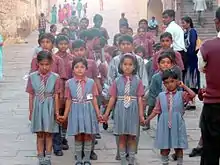


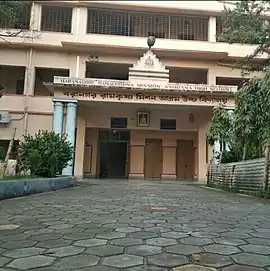
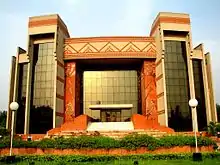

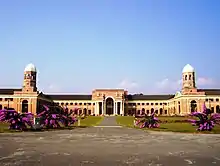
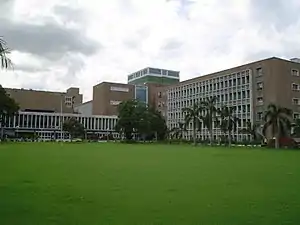
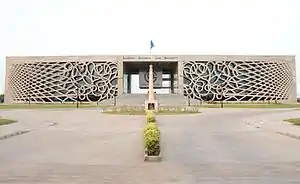

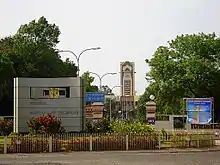
Building_IIT-Roorkee.JPG.webp)
.jpg.webp)